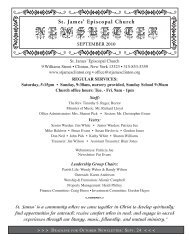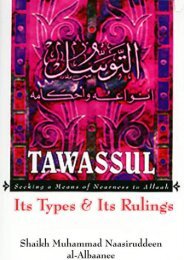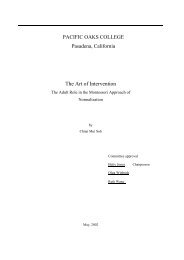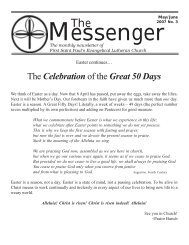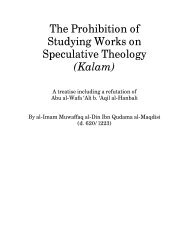Scripture and God in Christianity
Scripture and God in Christianity
Scripture and God in Christianity
You also want an ePaper? Increase the reach of your titles
YUMPU automatically turns print PDFs into web optimized ePapers that Google loves.
probably for the follow<strong>in</strong>g reason: It was known that this view of Jesus was not enterta<strong>in</strong>ed by<br />
the disciples dur<strong>in</strong>g Jesus' lifetime. In the tradition this fact took the form of the oft-repeated<br />
thought that the disciples did not underst<strong>and</strong> until later what Jesus was endeavor<strong>in</strong>g to teach<br />
them." 389<br />
Acceptance of this approach has significant implications upon our underst<strong>and</strong><strong>in</strong>g of Christology<br />
as Perr<strong>in</strong> observes: "The acceptance of the fact that synoptic say<strong>in</strong>gs have a history <strong>in</strong> the tradition<br />
makes a great deal of difference to the study of Christology, especially <strong>in</strong> connection with<br />
the beg<strong>in</strong>n<strong>in</strong>gs of Christology, because it raises serious questions with regard to say<strong>in</strong>gs which<br />
hitherto have been held to tell us someth<strong>in</strong>g about Jesus' underst<strong>and</strong><strong>in</strong>g of himself <strong>and</strong> <strong>in</strong> this way<br />
to mark the beg<strong>in</strong>n<strong>in</strong>g of Christology." 390 He further argues that "What is true of the Son of man<br />
Christology is certa<strong>in</strong>ly go<strong>in</strong>g to be true of the other christological patterns, those us<strong>in</strong>g Son of<br />
<strong>God</strong>, Son of David, Christ, Lord, <strong>and</strong> so on, for none of these has anyth<strong>in</strong>g like the secure place<br />
<strong>in</strong> earliest <strong>Christianity</strong> that the Son of Man has." 391 R. Augste<strong>in</strong> asks that "If Jesus was neither the<br />
Messiah nor the son of man nor the son of <strong>God</strong>, <strong>and</strong> if he did not even th<strong>in</strong>k he was any of those,<br />
what is left? ...what good could his death do?" 392<br />
Professor J. W. Bowker of the University of Lancaster, on the other h<strong>and</strong>, emphasizes that Jesus<br />
used this term as an alternative for the first pronoun "I" or "me" or to denote himself as a frail<br />
mortal. 393 K. Armstrong observes that " the orig<strong>in</strong>al Aramaic phrase (bar nasha) simply stressed<br />
the weakness <strong>and</strong> mortality of the human condition. If this is so, Jesus seems to have gone out of<br />
his way to emphasize that he was a frail human be<strong>in</strong>g who would one day suffer <strong>and</strong> die." 394 J. D.<br />
Crossan argues that "if Jesus spoke about a son of man, his audience would not have taken the<br />
expression <strong>in</strong> either a titular or a circumlocutionary sense but, follow<strong>in</strong>g normal <strong>and</strong> expected usage,<br />
<strong>in</strong> either a generic (everyone) or an <strong>in</strong>def<strong>in</strong>ite (anyone) sense. He is talk<strong>in</strong>g, they would presume,<br />
about human be<strong>in</strong>gs, mak<strong>in</strong>g claims or statements about humanity. An unchauv<strong>in</strong>istic English<br />
translation would be "the human one". 395<br />
Many New Testament scholars argue that Jesus used this term for himself <strong>in</strong> light of the well<br />
known Danielic Son of man <strong>and</strong> apocalyptic literature. C. F. D. Moule, for <strong>in</strong>stance, says that the<br />
title Son of man " seems to have come through virtually unmodified from Jesus himself." 396 He<br />
further states that "there is a strong case (or it seems to me) for the view that the phrase belonged<br />
orig<strong>in</strong>ally among Jesus' own words as a reference to the v<strong>in</strong>dicated human figure of Dan. 7 <strong>and</strong> as<br />
a symbol for the ultimate v<strong>in</strong>dication of obedience to <strong>God</strong>'s design." 397 Jeremias observes, that "It<br />
would be an error of method to suggest without further ado that these rema<strong>in</strong><strong>in</strong>g Son of man say<strong>in</strong>gs<br />
may be regarded as authentic, lock, stock <strong>and</strong> berrel." 398 But he concludes, that "the apocalyptic<br />
Son of Man say<strong>in</strong>gs which we have recognized as the earliest stratum must <strong>in</strong> essentials go<br />
back to Jesus himself." 399 Ben Wither<strong>in</strong>gton claims a sort of consensus among scholars over this<br />
issue observ<strong>in</strong>g that "One of the most complex problems <strong>in</strong> the New Testament studies is how to<br />
underst<strong>and</strong> the one label almost all scholars agree Jesus used of himself-the Son of man. 400 de<br />
Jonge makes almost the same claims. 401<br />
Scholars also differ over the true mean<strong>in</strong>gs of Daniel 7. Their views could be summarized <strong>in</strong><br />
three man categories. (1) The figure mentioned <strong>in</strong> the Danielic vision refers to one or more angels.<br />
J. J. Coll<strong>in</strong>s persuasively argues this view. 402 (2) It st<strong>and</strong>s for Israel, or at least for faithful<br />
47





